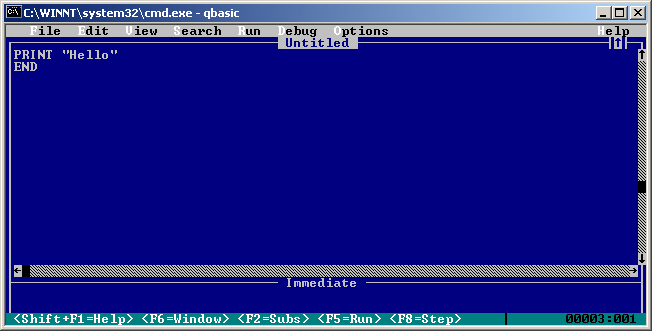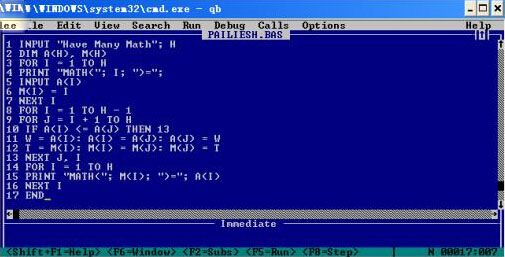

(I have not actually tried this myself, but I know that the port number can be reassigned for at least some devices.)Ġ The listing uses offsets from segment 0040h instead of segment zero, but that’s just different notation for the same physical address.
#Qbasic 4.5 for windows 7 serial#
But it also gives us another alternative: one may simply try reassigning the serial port number to a lower one to make it available with the expected device name and I/O address in the DOS box. This means that the I/O ports available in the DOS box do not have to correspond to the same I/O ports that the host system uses natively. If that’s the case, it’s worth remembering that DOS boxes are virtualised environments that don’t have direct access to hardware anyway: I/O port traffic is handled by the DOS virtual machine and passed to the appropriate Windows driver, which may map it to a completely different device. However, the question seems to imply that the BASIC program is run in a DOS box under Windows. Without knowing the specific device which provides the ports, it’s not feasible to say much more, or explain how Windows manages to discover those ports.
#Qbasic 4.5 for windows 7 driver#
1 Or perhaps not at all: it may be possible to access such a port via a DOS driver (by opening a handle to the COM device file and using DOS system calls to interact with it) or interrupt &h14 (though in BASIC that is only possible by calling assembly code, e.g. Run Qbasic under Windows 7, 8, and 10 (both 32 bit and 64 bit) within DOSBox or VMware Player: QBasic with Windows. If the machine has more serial ports than can fit in the BDA, the base I/O port address will have to be obtained in some other way. MEM 0040h:000Eh - SEGMENT OF EXTENDED BIOS DATA SEGMENT (PS/2, newer BIOSes) MEM 0040h:000Eh - BASE I/O ADDRESS OF FOURTH PARALLEL I/O PORT (pre-PS/2) MEM 0040h:000Ch - BASE I/O ADDRESS OF THIRD PARALLEL I/O PORT MEM 0040h:000Ah - BASE I/O ADDRESS OF SECOND PARALLEL I/O PORT MEM 0040h:0008h - BASE I/O ADDRESS OF FIRST PARALLEL I/O PORT MEM 0040h:0006h - BASE I/O ADDRESS OF FOURTH SERIAL I/O PORT MEM 0040h:0004h - BASE I/O ADDRESS OF THIRD SERIAL I/O PORT MEM 0040h:0002h - BASE I/O ADDRESS OF SECOND SERIAL I/O PORT

MEM 0040h:0000h - BASE I/O ADDRESS OF FIRST SERIAL I/O PORT

In the MEMORY.LST file from Ralf Brown’s, we can find the following entries 0: Well, this is to be expected the BIOS Data Area has only four slots for I/O addresses of serial ports, with slots for parallel ports immediately following.


 0 kommentar(er)
0 kommentar(er)
